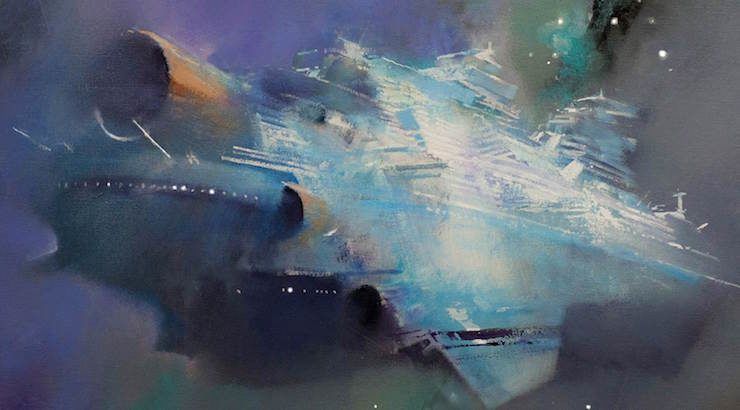There’s something about science fiction and fantasy that encourages collaboration. Whether it grew from the years when genre writing was relegated to the literary shadows, and authors came together to support each other, or it’s simply a tradition that found fertile ground here, collaboratively written novels abound in the genre.
The Mote in God’s Eye by Larry Niven and Jerry Pournelle
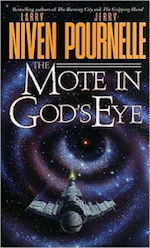 Set a thousand years in the future, in a culture still recovering from the civil war that caused the fall of the first human empire, this novel is a classic of first contact and the first collaboration of many between Niven and Pournelle. After a slower-than-light alien spaceship arrives in a nearby system, a human expedition is scrambled to visit a red supergiant star called Murcheson’s Eye and investigate the spaceship’s origin. Unlike many aliens-meet-humans books, here first contact comes on human terms, and it’s wildly original. The aliens are complicated, secretive, and intriguingly other, and the book is a thoughtful page-turner.
Set a thousand years in the future, in a culture still recovering from the civil war that caused the fall of the first human empire, this novel is a classic of first contact and the first collaboration of many between Niven and Pournelle. After a slower-than-light alien spaceship arrives in a nearby system, a human expedition is scrambled to visit a red supergiant star called Murcheson’s Eye and investigate the spaceship’s origin. Unlike many aliens-meet-humans books, here first contact comes on human terms, and it’s wildly original. The aliens are complicated, secretive, and intriguingly other, and the book is a thoughtful page-turner.
After this success, Niven and Pournelle went on to write other classics together such as Lucifer’s Hammer, Inferno and Footfall (still one of the best and most realistic alien invasion novels out there). They’ve also both had fruitful collaborations with numerous other SF authors, including David Gerrold, Steven Barnes, Dean Ing, Poul Anderson, and Gregory Benford.
The Difference Engine by Bruce Sterling and William Gibson
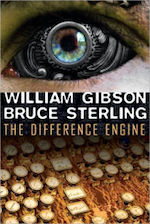 What happens when two masters of the cyberpunk genre put their heads together? Surprisingly, not more cyberpunk. Instead, what emerged was this unusual novel that posited an alternate version of Victorian England. Here, experiments by Charles Babbage resulted in a successful early mechanical computer and a very different industrial revolution. Starring airships, spies, courtesans and even Ada Lovelace, the dense and complex story revolves around the search for a set of powerful computer punch cards.
What happens when two masters of the cyberpunk genre put their heads together? Surprisingly, not more cyberpunk. Instead, what emerged was this unusual novel that posited an alternate version of Victorian England. Here, experiments by Charles Babbage resulted in a successful early mechanical computer and a very different industrial revolution. Starring airships, spies, courtesans and even Ada Lovelace, the dense and complex story revolves around the search for a set of powerful computer punch cards.
Sound familiar? Not surprising: this collaboration helped bring the relatively obscure steampunk genre to wider popular notice and launched a thousand steam-powered airships and clockwork monsters.
Black Trillium by Marion Zimmer Bradley, Julian May, & Andre Norton
 Not unlike The Traveling Wilburys, this dream team of successful female fantasy authors came together to create the 1990s Trillium series. Each author had a princess to helm, and during this first novel in the series the princesses separately search for three magical talismans which will enable them to regain their kingdom and free their people. Black Trillium was co-written by all three authors, each writing from a different princess’s point of view. Subsequently, each writer got to create one of the sequels (with Juilian May writing two). Does it all seem a bit gimmicky at times? Well, sure (each princess is distinguished initially by their different coloured hair, for example), but a fantasy series where all the protagonists were female was groundbreaking.
Not unlike The Traveling Wilburys, this dream team of successful female fantasy authors came together to create the 1990s Trillium series. Each author had a princess to helm, and during this first novel in the series the princesses separately search for three magical talismans which will enable them to regain their kingdom and free their people. Black Trillium was co-written by all three authors, each writing from a different princess’s point of view. Subsequently, each writer got to create one of the sequels (with Juilian May writing two). Does it all seem a bit gimmicky at times? Well, sure (each princess is distinguished initially by their different coloured hair, for example), but a fantasy series where all the protagonists were female was groundbreaking.
Stardance by Spider and Jeanne Robinson
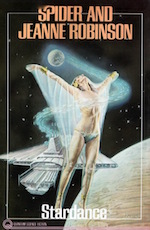 One of the few married co-author pairs in SF and fantasy, the Robinsons collaborated on three books in the Star series over the course of fifteen years, with Starseed and Starmind following the original Stardance, published in 1979. Stardance is the story of Shara Drummond, a gifted dancer and choreographer who creates a new art form in zero gravity (and not coincidentally also manages to use her dancing chops to help save the human race and start a new phase in human evolution). Readers certainly responded to it: the novel won both the Hugo and Nebula that year.
One of the few married co-author pairs in SF and fantasy, the Robinsons collaborated on three books in the Star series over the course of fifteen years, with Starseed and Starmind following the original Stardance, published in 1979. Stardance is the story of Shara Drummond, a gifted dancer and choreographer who creates a new art form in zero gravity (and not coincidentally also manages to use her dancing chops to help save the human race and start a new phase in human evolution). Readers certainly responded to it: the novel won both the Hugo and Nebula that year.
Leviathan Wakes by Ty Franck and Daniel Abraham writing as James S.A. Corey
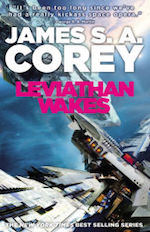 Now a cracking good TV series on the Syfy network, this first book of a projected nine novel series set a new standard for modern hard SF when it came out in 2011. Plenty of authors have written about the asteroid belt and the industrialization of the solar system before (including Larry Niven, decades back), but Franck and Abraham created an instant classic with their complex, believable cultures, great characters, and a page-turning story involving an alien molecule and conflict between Earth, Mars and the hard-done-by residents of the asteroid belt. Unusually among collaborative authors, Franck hadn’t written a book before Leviathan Wakes. Instead, his expertise was in worldbuilding: the universe of the novels in the series grew from ten years of RPG development.
Now a cracking good TV series on the Syfy network, this first book of a projected nine novel series set a new standard for modern hard SF when it came out in 2011. Plenty of authors have written about the asteroid belt and the industrialization of the solar system before (including Larry Niven, decades back), but Franck and Abraham created an instant classic with their complex, believable cultures, great characters, and a page-turning story involving an alien molecule and conflict between Earth, Mars and the hard-done-by residents of the asteroid belt. Unusually among collaborative authors, Franck hadn’t written a book before Leviathan Wakes. Instead, his expertise was in worldbuilding: the universe of the novels in the series grew from ten years of RPG development.
Bonus extra: Good Omens by Neil Gaiman and Terry Pratchett
This apocalyptic comedy about the birth of Satan’s son, a hospital-mixup and an angel and demon living in England who decide to work together to postpone the end of the world is a fan favorite, and came about as a collaboration between friends. It’s witty, sometimes ridiculous, squarely placed in the grand tradition of British humour and also manages to sneak in some thoughtful musings about free will and the nature of good and evil. Startlingly, considering how much he’s written, this was Gaiman’s first novel. It’s soon to be a six part TV series on Amazon Prime Video.
 Andrew Neil Gray and J. S. Herbison are partners in life as well as in writing. The Ghost Line is their first fiction collaboration, but won’t be their last: a novel is also in the works. They have also collaborated in the creation of two humans and preside over a small empire of chickens, raspberries and dandelions on Canada’s West Coast. There are many types of non-human intelligence in The Ghost Line. From a talking ship to synthetic dancing girls, to something more subtle. We hope we do a little justice to the idea that AI can be more than just a rampaging menace.
Andrew Neil Gray and J. S. Herbison are partners in life as well as in writing. The Ghost Line is their first fiction collaboration, but won’t be their last: a novel is also in the works. They have also collaborated in the creation of two humans and preside over a small empire of chickens, raspberries and dandelions on Canada’s West Coast. There are many types of non-human intelligence in The Ghost Line. From a talking ship to synthetic dancing girls, to something more subtle. We hope we do a little justice to the idea that AI can be more than just a rampaging menace.










